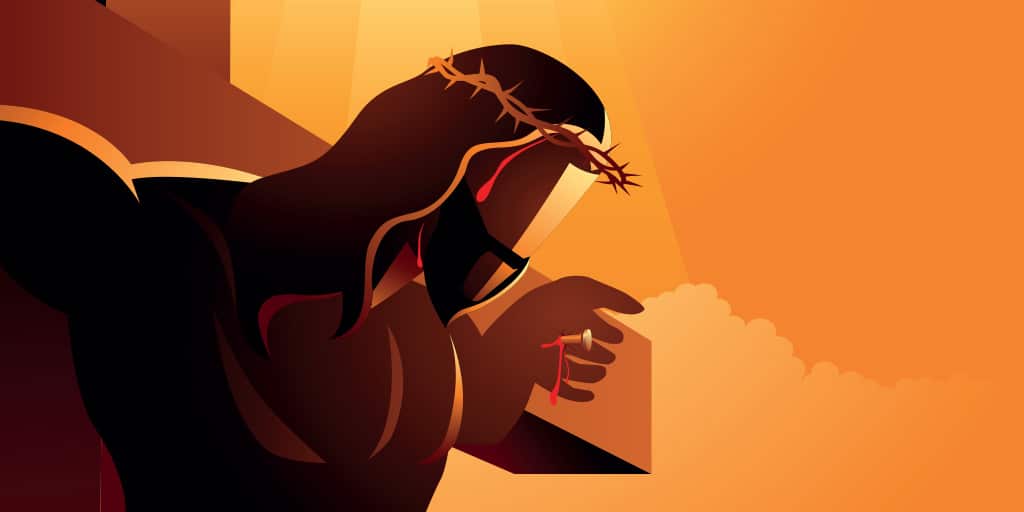Holy Week: Our Passover Lamb

THE LAMB FOR ETERNITY
The Bible concludes with the Revelation of Jesus Christ’s promised return, holy judgment, and Kingdom’s reign. Throughout its twenty-two chapters, various names and descriptors magnify His glory, nature, and character. One of the eternal references to Jesus is “The Lamb.” John’s vision in Revelation 5 describes the Sovereign One sitting on Heaven’s throne, holding a book sealed with His divine decrees. A mighty angel proclaimed, “Who is worthy to open the book and break its seals?” This unparalleled moment filled Heaven and Earth with a holy silence. The Apostle John testifies in Revelation 5:6-7, “And I saw between the throne (with the four living creatures) and the elders a Lamb standing, as if slain…. He came and took the book out of the right hand of Him who sat on the throne.” Every voice in Heaven, on Earth, and under the earth responded together in worship, “To Him who sits on the throne, and to the Lamb, be blessing and honor and glory and dominion forever and ever.”
Sin’s entry into creation did not force God to search for a solution. Revelation 13:8 tells us Jesus is the Lamb slain from the foundation of the world. Jesus has always stood and will forever stand as the unblemished and spotless Lamb whose precious blood holds redemption’s power. In light of eternity, let’s examine the beautiful unveiling of the Lamb from the end to the beginning.
THE LAMB FOR THE WORLD
From Heaven’s throne, Jesus humbled Himself as the Son of God and became the Son of Man. He grew up with no stately form or majesty (Isaiah 53:2). He was in the world, and although the world was made through Him, the world did not know Him (John 1:10). John the Baptist inaugurated the public ministry of Jesus by declaring, “Behold, the Lamb of God who takes away the sins of the world!” After three years of teaching in synagogues, preaching the Kingdom’s gospel, and healing all manner of diseases, the time had come to fulfill the divine purpose of being God’s Lamb. As the Scriptures foretold, Jesus entered Jerusalem’s gates as God’s chosen Lamb on the tenth day of the first month. From the crowd’s cries of Hosanna, the Lamb endured the thorough inspection of the religious leaders. Although attempting every means to indict, they could find no fault in Jesus. Even the Roman political inquisitions could find no blemish within Him. At Passover’s twilight, God’s predetermined day and time, Jesus was crucified as the spotless Lamb of God, paying redemption’s price in full.
THE LAMB FOR ISRAEL
For almost 1500 years leading to the crucifixion of Jesus, Israel celebrated the Passover Feast in Jerusalem on the fourteenth day of the first month. The Lord commanded the Passover’s location, date, and offering in Leviticus 23:4-5, “These are the appointed times of the LORD, holy convocations which you shall proclaim at times appointed for them. In the first month, on the fourteenth day of the month at twilight is the LORD’s Passover.” And to those entering the Promised Land, Moses further clarified the command, “You shall sacrifice the Passover to the LORD your God from the flock and the herd, in the place where the LORD chooses to establish His name” (Deuteronomy 16:2). The Levitical priests inspected every one-year-old male lamb, and if deemed spotless, it became that family’s fulfillment of God’s command to bring it as a sacrifice. The lamb’s blood served as an atonement for the sins of the people. Sin’s judgment is death. Instead of God requiring our death, God accepted the lamb’s blood as atonement’s price. Scripture clearly says in Leviticus 17:11, “For the life of the flesh is in the blood, and I have given it to you on the altar to make atonement for your souls; for it is the blood by reason of the life that makes atonement.” Therefore, year after year and generation after generation, Israel brought untold numbers of lambs on Passover for atonement’s peace.
THE LAMB FOR THE FIRSTBORN SON
The yearly sacrifice of a Passover lamb did not begin within the borders of the Promised Land but instead from the land of Egypt. God appointed Moses to bring Israel out from their Egyptian captors of 430 years. God displayed His power through nine plagues over Egypt, but God hardened Pharoah’s heart so that he would not let Israel go—that is, until the tenth and final plague. On the tenth day of the first month, God commanded each home of Israel to take under their care a male, one-year-old, unblemished lamb. They were to keep (and inspect) the lamb until the fourteenth day of the first month. It would be on this day at twilight that all of the congregation of Israel was to kill their lambs. They were commanded to put the lamb’s blood on the two doorposts and lintel of their houses. That same night, on the fourteenth day of the first month, the angel of the Lord would “pass over” every home. To those who were obedient and placed the blood on their doorposts, their firstborn sons would live. To those who refused, their firstborns would die. The lamb’s blood served to save the lives of their firstborn sons. This was the first Passover, and God told them to celebrate it every year on that day for all generations.
THE LAMB FOR A PERSON
The long shadow of Christ, the Lamb of God, is visible two thousand years before the cross. God’s plan for humanity’s restoration involved an unconditional covenant made with Abram (Abraham). God alone would accomplish His promises to Abraham of a specific land, many descendants, and worldwide blessing (Genesis 12:1-3). These promises would begin with a miraculous birth to Abraham and his wife Sarah of a son, Isaac. God tested and proved the faith of Abraham when He commanded him to sacrifice Isaac on top of Mount Moriah. Abraham took his beloved son, placed the altar’s wood in Isaac’s arms to carry, and took the fire and knife in his hand. Genesis 22:7-8 continues the story, “Isaac spoke to Abraham his father and said, ‘My father!’ And he said, ‘Here I am, my son.’ And he said, ‘Behold, the fire, and the wood, but where is the lamb for the burnt offering?’ Abraham said, ‘God will provide for Himself the lamb for the burnt offering, my son.’” So, the two of them walked on together. God did spare Isaac’s life from being the fate of being the lamb and, in his stead, provided a ram discovered in the thicket.
THE PASSOVER TABLE
God the Father prepared His Passover sacrifice in God the Son even before sin entered creation. Our redemption through His beloved Son’s death has always been His divine plan. When the hour eternity had longed for came, Jesus sat at the Passover table with His disciples. This night was unlike any other night. The twelve men reclining for the yearly meal did not understand Jesus when He said, “I have earnestly desired to eat this Passover with you before I suffer….” There is no way their finite hearts could grasp creation’s groaning for this moment. Their earthly ears couldn’t hear the Father’s love, the Spirit’s intercession, or Heaven’s hope. At their table sat the Lamb, whose blood would satisfy sin’s full price and in whom God’s redemptive plan would be accomplished. Nor could they understand when Jesus said, “…for I say to you, I shall never again eat it until it is fulfilled in the kingdom of God.” But we do understand. Jesus waits for all those with His blood placed by faith upon the doorposts of their hearts to come to His Passover table. It will then be the Passover Meal that we will celebrate with the Lamb, who took away the sins of the world. We, the sons and daughters of the most High God, now can understand, believe, and proclaim, “Jesus Christ is our Passover Lamb…. Therefore let us celebrate the feast, not with old leaven, nor with the leaven of malice and wickedness, but with the unleavened bread of sincerity and truth, …knowing that you were not redeemed with perishable things like silver or gold from your futile way of life inherited from your forefathers, but with precious blood, as of a lamb unblemished and spotless, the blood of Christ” (1 Corinthians 5:7-8, 1 Peter 1:18-19).







